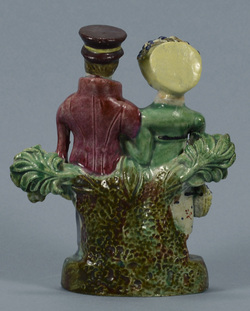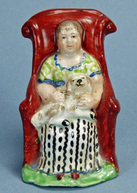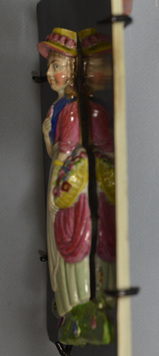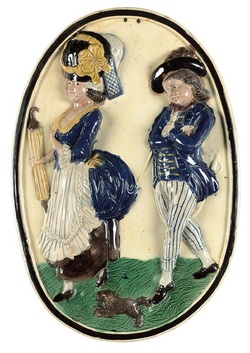
As you see, the back is a bit unusual. I wish I had photographed the interior for you. The glaze is a heavy blue, and in parts it did not coat the interior. Very pretty if you are into bases, and I, of course, am!
|
I have been working with several collections recently, and this has given me the opportunity to see some splendid dandies. Who does not like dandies? I don't think any collection can ever have too many. The little couple below--I call them "dumpy dandies"--is quite rare. It measures all of 4.5" in height, and the somber expressions and stumpy bodies are adorable. This couple lacks that air of superior indifference that fashionable dandies strove to exude--but they tried to dress the part anyway.  As you see, the back is a bit unusual. I wish I had photographed the interior for you. The glaze is a heavy blue, and in parts it did not coat the interior. Very pretty if you are into bases, and I, of course, am! I also photographed this spiffy pair. They can be attributed to the Patriotic Group (see Vol. 1 of my new book this fall for details....and Vol. 3 has a chapter on just Dandies.) If you look carefully, you can see that the couple on the right is just a bit bigger, a tad chunkier. Clearly, this is a pair, but I wondered if they perhaps might have been fired at different times or in different places in the kiln, resulting in varying shrinkage rates in firing. Then I noticed the same discrepancy in the pairs below. Again, the couple where the lady has the flat hat is slightly bigger. These pairs, however, were made by the "Sherratt" pot bank. Despite the close similarity to the Patriotic Group dandies above, the molds are actually different. I wish I could explain...but it is what it is. Below you see the "Sherratt" dandies we have just looked at, but now they flank another pair from the same molds and with bocages. Yes, these are all "Sherratt." A wonderful sight, is it not? And to bring us full circle, below are the dumpy dandies that started this post, now standing between the "Sherratt" pair. Sometimes words fail me, but the pictures say it all.
2 Comments
I am puzzled as to why this sweet little figure has sat on Aurea Carter's site for a few days. I imagined it would be sold within hours. This figure is actually rare. The seated lady holds a cat, and I was thrilled when Aurea got this figure in time for me to pop it into Volume 3 of my new work. I have noted many Pratt ware figures of a seated lady with cat, but, until now, I had not seen an enamel-painted one--and never another from this mold. Her face is so pretty!  Seated ladies more commonly hold dogs, like the figure to the left. This is mine, and I am a dog lover...so I passed on Aurea's cat lady. Aurea's figure is £235. In other words, for under $400, you can get a rare early figure without major issues. How nice is that? I was talking with a veteran collector yesterday about the difficulty of starting collecting without diving in at the deep end, so this morning I scouted around to see what else could be had for $500 or less. The good news is that there is plenty. The two figures below are both on Aurea's site. I have a little reading boy rather like the boy on the left, and I love it. The figure on the right is attributed to Ralph Wood. An eighteenth century figure with no repairs or restorations for £155 (under $250). How ridiculously cheap is that? Aurea does not have the monopoly on fine, low-priced figures. If you look around, you will find plenty of others. The virtually perfect figures of Simon and the cherub below are on Andrew Dando's site at below $500....and Andrew has other figures that are compelling value. The group of two boys scuffling below is one of several figures on Barbara Gair's site for well under $500, as is the sweet girl-with-basket . Of course, I couldn't miss out Martyn Edgell's well stocked site, and Martyn has figures (see below) in acceptable condition from as little as £39, and for a whole £165, you can buy a perfect lion. I usually advise beginning collectors to buy a few virtually perfect figures to help them know what they should be seeking in the future. As you see, many dealers have something suitable to get collectors going at a modest cost. Will you 'out grow" these small figures as your collection evolves? Definitely not. Some of my little early purchases remain among my favorite possessions. But a note of caution: inexpensive figures that are cheap because they have extensive condition issues are not good value. In time, you will wish you had put your money elsewhere. Restoration cannot be avoided, but when you are buying an inexpensive figure, make sure it has minimal restoration.
I hesitate to call the object below a plaque. A plaque is made by pressing clay into one mold. Here, however, we have a figure of a girl applied to a clay slab. All in all, the result is quite extraordinary. Size is 8 inches by 6 inches. Perfect! (Please overlook the black hooks used for mounting and the slightly crooked angle. Definitely not my finest photograph!)  Viewed from the side, you can see the high relief. Also, there is a gap between the back of the girl and the clay slab. It extends along most of the length of her body. The figure was made separately in a mold, smoothed on the back, and then applied to the rectangular clay slab. At the very top and bottom, the figure sits snugly on the slab. So the first issue that drove me nuts when I looked at this is HOW did the painter paint black on the slab all the way under the figure without sloshing it up onto the figure itself? The figure is enamel-painted, and painting black enamel so as to evenly cover every scrap of space under the figure without getting black where it was not wanted would be impossible. I am fairly certain that the manufacture process went something like this:
The black appears to be colored glaze rather than enamel. In some parts it has run over the edge of the slab just like colored glaze does, i.e. with the black separating into a black-brown as it oozes. If the black were indeed enamel, the slab and the figure would have to have been made separately....but then a high-temperature firing to meld them together would have destroyed the enamel colors! So who made this gem? I have no way of attributing with certainty, but when I look at that face, it screams Ralph Wood.  The modelling of the girl's face really reminds me of the faces on the Patricia and her Lover plaque alongside. This is the finest plaque I have ever seen. It is attributed to Ralph Wood, and it is decorated entirely in colored glazes. Unlike the slab with the girl, it is molded in one piece. If you turn it over, there are hollows in the back that correspond to the raised figures in front. A large, magnificent object, and a true treat to hold. I get goosebumps just thinking about it. Look at the faces on the Patricia and her Lover plaque below. Note the hooded eyes and the expressions. Am I the only one who sees a strong family resemblance between Patricia and her lover and the figure of the young girl? Their daughter perhaps?? The figure of the young girl has an old label on the back that states the name of a previous collector. It goes on to add that he attributed it to Ralph Wood and that in his collection of over 300 figures, it was his favorite object. I find that easy to understand.
P.S. Look at the center of the Lover's hat, near the hair line. See how the black has run into brown as it thinned out over that area. You see the same dispersal pattern on the edge of the black clay slab, and that supports my belief that the black is indeed colored glaze. Religious groups are controversial. You either love them or hate them. But however you feel about the subject matter, you have to admire the quality of the two gorgeous groups below. On the left, is a group portraying the New Testament tale of Peter restoring the lame man. On the right, the group portrays the Old Testament tale of Samuel anointing young David as king of Israel. Although these two groups today live apart, it is apparent that they were designed as companions and they were made by the same pot bank. Why are the two groups companions? What is the connection between the New Testament and Old Testament tales? I have no idea. By the way, these groups can also be found with the feet painted brown. If you think the pairing of these seemingly unrelated stories is mere coincidence, look again. Here we have two groups on the same theme by yet another pot bank--and they clearly were intended as companions. I have dubbed the unknown pot bank that made the two groups immediately above "Box Title." More correctly, I call the group of figures from this pot bank the "Box Title Group." This cohesive group of figures share specific attributes, including--you guessed it--a title painted within a box-like frame, as you see above. Now before you take giant leaps of faith, know that groups of figures from other pot banks may also include titles within boxes. But there are other very specific features that help establish a Box Title attribution. Note the very stalky bocages. This is another clue to a Box Title attribution. Below are yet two more examples of these subjects but made without bocages. I don't know who made these, but I believe we have a third and perhaps a fourth pot bank at work here. Although these examples are not painted to pair, I do have in my archive a Peter Restoring the Lame Man that has the same vermicular pattern on the base as the Samuel Anointing David below right. Forgive the poor photos but they are restored images from a very old source. As so many pot banks evidently made these two groups as companions, there must be some connection between their two tales. But what??? I am stumped! If you know, please shout.
|
Archives
February 2024
All material on this website is protected by copyright law. You may link to this site from your site, but please contact Myrna if you wish to reproduce any of this material elsewhere. |